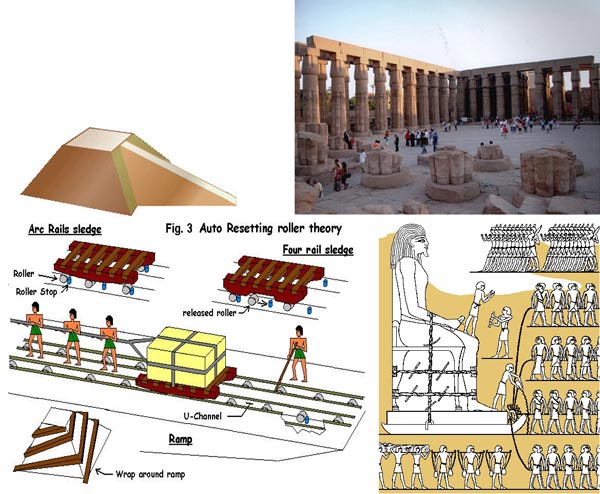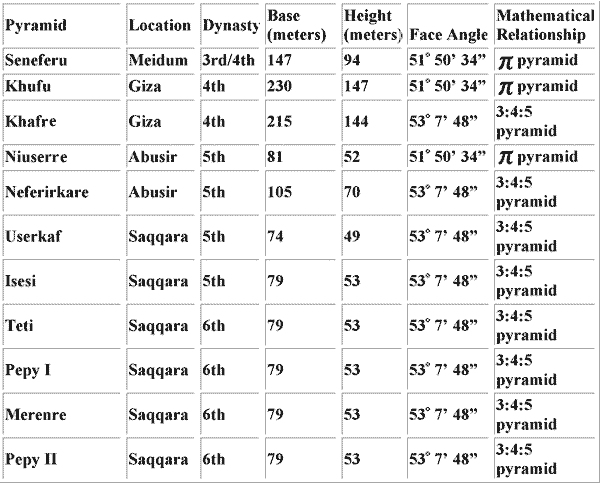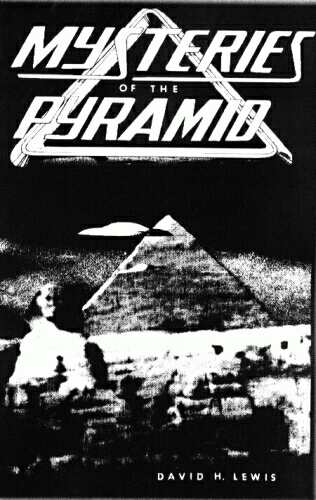
|
HiddenMysteries.com HiddenMysteries.net HiddenMysteries.org |
* * * * * * * * * * * * * * * * * * * * * * * * * * * * * * * * * * * * * * *
A word from our sponsor

Last of the ancient wonders: II- The Great Pyramid
Thursday, May 29 2008 @ 12:02 AM CDT
Increase font Decrease font
This option not available all articles
A wealth of lunacy is associated with the Great Pyramid. Assem Deif* suggests that unorthodox views ignore the provenance of the pyramid and its place in the context of the overall pyramid complex and necropolis

Clockwise from top: Pillars hall in Karnak Temple; a drawing featuring the removal of an ancient Egyptian statue; hexa temple; the Serapeum in Saqqara; a drawing sketching the construction work of the pyramid

It has variously been claimed that the pyramids served as power plants, water pumps, astronomical observatories, sources of ill-defined pyramid- power energy vortices, guidance beacons for alien spacecraft sites for mystery initiation ceremonies.
Unfortunately there remains no known written record as to how the most famous of the more than 100 pyramids in Egypt, the Great Pyramid of Giza, was built, nor have any reliefs depicting the building ever been found. The Greek geographer Herodotus, writing in the fifth century BC, mentioned the theory that levers were used to lift pyramid stones. Perhaps this is the most tenable of the alternate theories; as reported by Egyptologist Selim Hassan in his opus Ancient Egypt, Part 1, Cairo, 2000, p. 288. Hassan verified Herodotus's theory based on excavation conducted by Cairo University in the mid-20th century on the Giza Plateau, where the debris of two pulleys were found, one near the second pyramid and one inside the workmen's village east of the valley.
Leaving aside this theory, Egyptologists generally agree that the heavy blocks were most probably lifted into place by maintaining an ascending ramp of fractured pebbles. This view was supported by the discovery at Saqqara of an unfinished pyramid for King Sekhem-Khet of the Third Dynasty, where ascending ramps were found. This view of ascending roads is not shared by the Danish engineer Garde- Hanson, who reckoned that such a ramp as needed for the Great Pyramid would require 13,400,000 m3, seven times the amount of material used for the pyramid itself and necessitating a work force of 240,000 to build the ramp alone during Khufu's reign. Moreover, it would then require a workforce of more than 300,000 to dismantle it in a space of at least eight years. Even if such a ramp were to have been built on only one side of the pyramid, it would have required three times the pyramid volume instead of seven. However, since the ramp inclination could be at most to allow for the pulling of the heavy blocks, it would be about 10km long. In addition, to be able to support the weight of the stones the ramp would need to be made of nothing less in strength than the limestone material of which the stones themselves are made. These engineering facts cannot be disputed, and explain why there is as yet no convincing theory concerning the construction.
As for how the stones were transported to the site, no texts or even reliefs describing this operation remain. Egyptologists agree that the wheel was not yet invented, indeed the first recording of large blocks being moved with wheels comes 2,000 years after the Great Pyramid was built. However a relief from the tomb of Djehutihotep, created 800 years after the Great Pyramid was built, shows 172 men pulling a huge statue over flat ground with a two-rail, flat-bottomed sledge. Some type of liquid, presumably a lubricant, is being poured in front of the sledge. Another illustration dating 1,000 years after the building of the Great Pyramid, the Turah Stele, shows three oxen pulling a block of stone on a similar sledge.
What is definite is that the magnificent pyramids of Giza (built c. 2500 BC) attest to the ancient Egyptians' accurate measuring ability, pointing to advanced knowledge in mathematics or geodesy. The Great Pyramid of Khufu, the greatest single building ever erected, used about 2,300,000 limestone blocks each weighing 2.5 tonnes on average, all precisely cut and none weighing less than two tonnes. Simple calculations show that, since it took 20 years to complete, and assuming eight or 10 hours' labour a day, one block was fitted almost every minute, or rather accurately
In other words, it took about 10 minutes to fit neatly in place seven blocks. This does not take into account the time taken to pave or demolish the ramp as it was built up all the way to the top of the pyramid, according to the general theory. Building and demolishing such a ramp would not only have required 500,000 workmen, but this alone would have taken the whole of Khufu's reign. Nor does it account for the time spent levelling the rocky site, nor for the time taken to position the nine granite blocks of 50 tonnes each constituting the inside of the royal chamber, nor the time to cover the whole edifice with the 115,000 pieces of fine limestone casing, some of which weighed more than 16 tonnes. An experiment funded by the Nissan Company in 1979, in which a Japanese team tested the feasibility of building a scale model of the Great Pyramid using new technology, was abandoned after it was found it would take 1,000 years to finish.
The casing stones covering the monument are so perfectly shaped that the joint in between is just 0.5 mm, and not even a knife can slide into the crevasses between the stones. Egyptologist Flinders Petrie compared such precision to that of the "finest opticians", well beyond the capabilities of modern technology. He showed that there are no tool marks, and the corners are not even slightly chipped. Moreover, the granite coffin in the King's Chamber is cut from a solid block of hard granite so precisely that its external volume is exactly twice its internal volume. It was first suggested that it could have been cut and hollowed using bronze saws set with diamond cutting points, but this theory was refuted because, when pressure was applied, the diamonds would have worked their way into the much softer copper, leaving the granite virtually unscathed.
The Great Pyramid is usually presented as the wonder of the world, as if the second and third pyramids were a degradation from perfection. If the other two pyramids were as carefully analysed as the Great Pyramid, this notion would be hard to sustain. The pyramid of Khafre differs by less than 3m in height and with a steeper face angle. Recording these dimensions, Petrie found their mean error did not exceed .04 of an inch; that is 1 mm.
Yet the pyramid is not alone in engineering mastery. Take the sarcophagi in the Serapeum in Saqqara, which contained the funerary remains of Apis bulls. Each of these great stone boxes, which weighs at least 65 tonnes, stands about 3.5m high, 4m long, and 2.5m wide. Adding the weight of its lid, it would amount to an assembled weight of 100 tonnes. Each sarcophagus sits in its own sunken rock-cut niche, and these niches form rows along the bedrock walls. The surfaces of both the sarcophagi and their lids are perfectly flat. The air between the two stone surfaces was pushed out, producing a very effective seal. Dunn's mind staggered as he reckoned the technical difficulties of producing both the lid and the sarcophagus to fit in this ultra-precise way. No equipment exists in the present day that is capable of producing a comparable monolithic sarcophagus.
No two Egyptologists agree on the proportions of the Great Pyramid's dimensions. On average, based upon different observations, the height is 146.6m (481 ft) while the side of the square base is 230.4m long (756 ft). The sides agree in length within 0.05 per cent r, or less than 1/8000 of the total length. The pyramid's 107m long descending passage to the subterranean chamber is so straight that it deviates from a central axis by less than 5mm from side to side and only 2.5mm up and down; which compares with the best laser- controlled drilling done today. The descending passage and the ascending one beneath the Grand Gallery share the same angle of inclination of 26 18' 10".
Further, the ratio of the perimeter of the base to the height was set at 2. This is perhaps the most controversial of the Great Pyramid's features. Early surveyors found the error of the angles at the corners to be only 12", or about 1/27000 of a right angle. The angle of inclination of the pyramid sides is 51 50' 34", the secant of which is equal to 1.618590, being remarkably close to the Golden Ratio. On the other hand, the cotangent of the same angle is 0.7857143, very close to /4 (this sets the Egyptian to about 3.142857). The Egyptians were indeed unaware of such terminologies as "cotangent" or "secant", but they still had a variant of the former called Seqed. Interestingly, from the properties of the Golden Ratio and Pythagoras's theorem, it follows that the height OS in the figure must be proportional to OM in the ratio of and equally to 4/ : 1, i.e. that the square root of the secant times is very close to 4 (it should be exactly equal to 3.996168), which coincides with the observations as being 3.998463. This can hardly be a numerical coincidence.
The face angle of 51 50' 34" also appears in two other pyramids, those of Seneferu (Khufu's father) at Meidum and Niuserre of the fifth dynasty at Abusir. Archaeologists call this triplet the pyramids. Most striking is the repeated face angle of 53 7' 48" created by a triangle with proportions 3:4:5 corresponding to the ratios (half-base: height: slant height). Examples of these pyramids are cited in the table below. The dimensions are measured to the nearest metre.
The Great Pyramid is so well planned that it is perfectly aligned with the earth's four cardinals. more so than any known building, past or present. No wonder that it has been the most studied architectural object in the world. Vast literature is still produced in order to expose another view, measurement, or another theory that will explain the rationale or non-rationale of this ancient mystery. It stood as the most majestic and mysterious monument ever erected by man on the face of earth.
We shall not accept, however, the myth that space aliens or people from Atlantis arrived to help. Certainly, other Egyptian monuments are no less grandiose. The Karnak Temple complex contains 134 granite columns 22m high and 3.5m in diameter. There also exist obelisks 42m high and weighing 1,100 tonnes. How were the ancient Egyptians able to raise them to an upright position? How did they manage to transport the statue of Ramses II, 1,200-tonnes of granite in a single block, from Aswan to the Ramesseum? These are not the only puzzling technological issues. The Hawara pyramid of Amenemhat III, the greatest monarch of the Middle Kingdom -- the mortuary temple of which was called the "Labyrinth" by Herodotus and Diodorus and was praised by Strabo as one of the wonders of the world -- contained complex security features like those visualised in Hollywood films.
The heaviest known blocks to be brought from Aswan to Giza are the massive granite stones deployed for the roof of the King's Chamber in the pyramid of Khufu, each weighing 50 tonnes. The Fifth- and Sixth-Dynasty pyramids included gabled roofs with blocks weighing up to 90 tonnes. The mortuary temple of Menkaure included limestone blocks weighing 200 tonnes. In the 18th Dynasty, two colossal statues of Amenhotep III, called by the Greeks the Colossi of Memnon and each weighing more than 700 tonnes, were moved an overland distance of 700km. How was this possible? Perplexing, perhaps; but this does not mean the ancient Egyptians could not have been the sole creators of such splendours.
Apart from the Great Pyramid itself, there are plenty of other pyramids and monuments that were created without superhuman intervention. As if this were not evidence enough, the tombs of both the builders and the workmen on the Giza Plateau have been excavated. Builders' tombs situated in the upper part of the necropolis bear the titles: "the Supervisor of Pulling the Stones", "Head of the Builders" or "Head of the Sculptors". They matched graffiti left by the workmen on the pyramids' stones. Easy to read are "Friends of Khufu", "the Great Guys" or "Gang of Menkaure." Debris found in situ included pottery, bread ovens, bones and dried fish left by the people who lived once there. Far from being the slaves spoken of in legend, these builders erected edifices for their divine ruler who represented for them the "image of the god". They participated with pride in accomplishing Egypt's national project. From time to time we come across graffiti like "the Craftsmen's Gang", "the Victorious Gang" or "the Enduring Gang", names that imply the workmen's pride in their work.
The Great Pyramid is the outcome of a long history of tomb design. As such, it did not arrive suddenly; rather as a progressive evolution from previous edifices starting from the early pre-dynastic mastabas and passing through Djoser's Step Pyramid to end with the Red Pyramid, Egypt's first true pyramid, setting the familiar shape of the Fourth Dynasty.
Even the weight was progressive, commencing with the Step Pyramid at about one million tonnes, to Meidum at 1ð million, Seneferu's other pyramid, the Bent Pyramid, at 3ð million tonnes, and finally the Great Pyramid at more than six million tonnes. Further, in most of the pyramids the entry passages to the burial chamber simulates a telescope to the celestial pole. We can therefore dismiss theories related to aliens or some lost culture as being responsible for their construction. There is just far too much evidence, including evolutionary changes, workmen's villages, tools, drawings and graffiti to rule such ideas obsolete.
One theory that often surfaces is that the Great Pyramid is made of concrete moulded on site. This hypothesis can easily be refuted, since the material of the blocks can be analysed for substance. This alleged theory found some credence based on the difficulty of achieving the close fit of 1/50th of an inch, i.e. ðmm, for the original casing stones with primitive tools. According to the concrete theory, such joints are easily achieved. Any civil engineer, however, will tell you that cast concrete looks very different. Photographs of the blocks clearly show the marks of flat as well as pointed tools of the workmen as they chiselled their way across the block.
The pyramids raise many riddles waiting to be resolved. As centuries unfold, their mystery becomes more and more puzzling, not only in how the ancient Egyptians were capable of building such colossal monuments, but also with such an astounding speed and splendour. They have stood in the Nile Valley for 5,000 years. As was once said: "Man fears time, yet time fears the pyramids."
* The writer is a professor of mathematics at Cairo University and Misr University for Science and Technology.
http://weekly.ahram.org.eg
Last of the ancient wonders: Part 1- The Great Pyramid
http://hiddenmysteries.net/geeklog/article.php?story=20080104220757285
Other articles by this outstanding author:
The Amazing Golden Ratio
http://hiddenmysteries.net/geeklog/article.php?story=20070928001346623
Mathematics in Ancient Egypt
http://hiddenmysteries.net/geeklog/article.php?story=20070126200612346
A QUESTION OF ANCIENT MATHEMATICS
http://hiddenmysteries.net/geeklog/article.php?story=20070517082023165
The Ahmes Code
http://hiddenmysteries.net/geeklog/article.php?story=20070512093125130
**************************

http://hiddenmysteries.com/xcart/product.php?productid=18012

http://hiddenmysteries.com/xcart/product.php?productid=18749

http://hiddenmysteries.com/xcart/product.php?productid=17678
Comments (0)
* * * * * * * * * * * * * * * * * * * * * * * * * * * * * * * * * * * * * * *
A word from our sponsor

HiddenMysteries
Main Headlines Page
Main Article Page
Last of the ancient wonders: II- The Great Pyramid
http://www.hiddenmysteries.net/newz/article.php/20080215100021494
Check out these other Fine TGS sites
HiddenMysteries.com
HiddenMysteries.net
HiddenMysteries.org
RadioFreeTexas.org
TexasNationalPress.com
TGSPublishing.com
ReptilianAgenda.com
NationofTexas.com
Texas Nationalist Movement